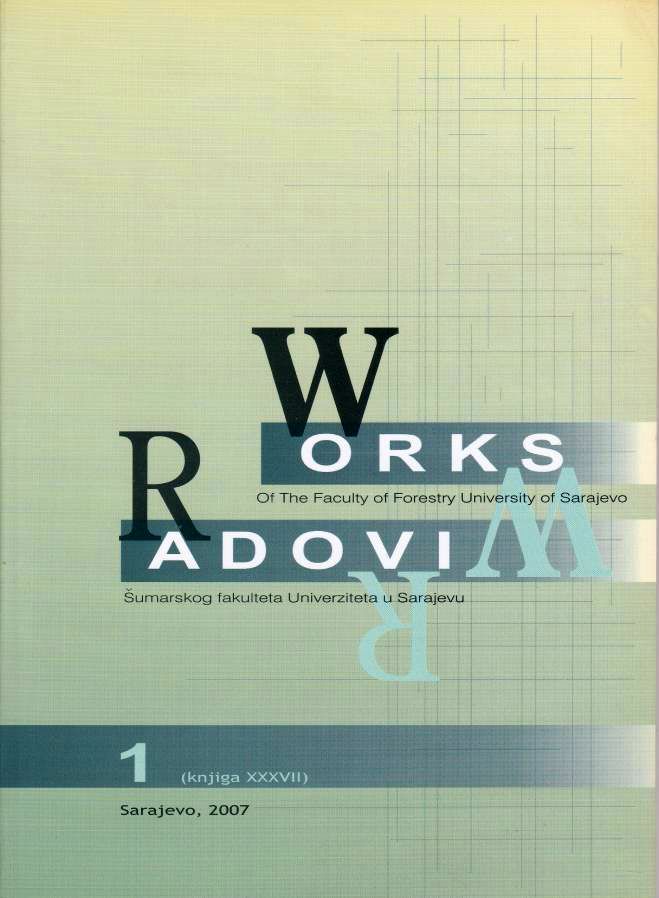Ecological and biosystematic characteristics of stone crayfish Austropotamobius torrentium (Shrank, 1803.) from the Nahorevo brook
DOI:
https://doi.org/10.54652/rsf.2007.v37.i1.182Keywords:
stone crayfish, Condition factor, quality of water, distribution, habitat, varianceAbstract
UDK 595.371(497.6 Sarajevo)
Over the period from august 2006 and May 2007, we harvested samples of stone crayfish from the Nahorevo stream. We caught a total of 10 units, five males and five females. Te species Austropotamobius torrentium (SHRANK, 1803) inhabits the streams with good quality waters which has been confirmed by this paper. The analysis included general physical/chemical conditions in water (oxygen regime, temperature, conductivity, water hardness, azoth compounds, phosphates). We determined a high level of oxygen, low temperatures, but high values of BPK5 (2,48 mg/l), which is the result of an increased consumption of oxygen for biodegradation of the present alochton organic matter in the water flow. Based on the analysis of the qualitative and quantitative content of zoobenthics we calculated the saprobe index (S=1,53) which points at cleanliness of the water with insignificant quantity of organic matter. The results of the measurement of lengths of the units of stone crayfish point at the greatest lengths of males and females of up to 7 cm, and the smallest length was bellow one centimeter. The measured lengths of the crayfish coincide with the results from previous reports by STREISSL, F., HÖDL,W. 2002, PEKNY, R., HAGER, J. 2004, MAGUIRE, I., KLOBUČAR, G.I.V. 2003. By calculating the variance it was determined that the length in both sexes is the most variable value, and the least variables were determined in the weight of the examined units. The measured values of weight and total length were calculated based on two indexes of condition: Fulton´s Conditions Factor (RICKER, 1975), Crayfish Constant, (ADEGBOYE, 1981). Based on the obtained values the conditions existing in the waters of the Nahorevo stream are more favorable for male, which was confirmed by previous studies in Austria (STREISSL, HÖLD, 2002). Stone crayfish or stream crayfish Austropotamobius torrentium has been the subject of numerous studies for a lengthier period of time in the region of Europe, including familiarization with biology and ecology of this species. The species does not have the status of saprobe indicator yet, and according to results of the studies, we cannot report, with an absolute certainty, about optimal conditions for its existence. The area of Bosnia and Herzegovina has an abundance of waters and other natural resources and an overall biodiversity, thus, in the future we expect much more comprehensive and extensive data which will give a broader overview of the habitat and density of the crayfish population. The contribution of this paper is in the presentation of the crayfish habitat that has been described as such for the first time in Bosnia and Herzegovina.
Downloads
References
ADEGBOYE, D., 1981. The ‘Crayfish Condition Factor’ a tool in crayfish research. Freshw. Crayfish 5: 154–172.
BEDJANIČ, M. (2004): Novi podatki o rzširjenosti raka navadnega koščaka Austropotamobius torrentium (Shrank, 1803) v Sloveniji (Crustacea: Decapoda). Natura Sloveniae, 6(1): 25-33.
BERTOK, M., BUDIHNA, N., POVŽ, M. (2003): Strokovne osnove za vzpostavljanje omrežje Natura 2000: ribe (Pisces), piškurji (Cyclostomata), raki deseteronožci (Decapoda): Končno poročilo. Ministarstvo okolje, prostor in energijo, ARSO, Zavod za ribištvo Slovenije, Ljubljana.
BERTOK, M., BUDIHNA, N., POVŽ, M. SELIŠKAR, T. (2004): Ribe, piškurji, slatkovodni raki deseteronožci. Proteus, 66 (9-10): 462-468.
DEDIĆ, M. (2005): Biosistematske karakteristike riječnog raka Astacus astacus Linnaeus, 1785 iz Boračkog jezera: diplomski rad. Prirodno-matematički fakultet Sarajevo, Sarajevo.
De LUISE, G., LIBERATO, C., DI CRISTO, C., DI COSMO, A., PAOLUCCI, M. (2004) : Population analysis of Austropotamobius torrentium in the Friuli Venezia Giuli Region. Dept of Biological and Enviromental Sciences, Faculty of Sciences, University of Sannio, Benevento.
European native crayfish in relation to land–use and habitat deterioration with a special focus on Austropotamobius torrentium, September 8 – 11, 2004, Innsbruck.
EDSMAN, L., TAUGBøL, T. (2004): Crayfish in Scandinavia – socioeconomic significance and consrevation aspects. Institute of Freshwater Research, National Board of Fisheries, Norwegian Institute for Nature Research, Fakkelgaarden, Drottningholm, Lillehammer.
FŸREDER, L., SINT, D., LEITER, J., DECLARA, A. (2004) : Species protection programs on autochthonous crayfish in Tyrol, Austria and Italy. Institute of Zoology and Limnology, University of Innsbruck, Innsbruck.
HUBER, M. G. J., SCHUBART, C. D. (2004): Genetic analysis of the stone Crayfish (Austropotamobius torrentium) in Germany on the local distribution around Regensburg and the impact of alien crayfish species. Universität Regensburg Leehrstuhl Zoologie, Regensburg.
KARAMAN, M. (1976): Desetonogi rakovi – Decapoda. Prirodonaučen muzej na Makedonija, Skoplje, Fauna na Makedonija II.
MATONIČKIN, I. (1991): Beskralješnjaci: biologija viših avertebrata. 2 izd., Školska knjiga, Zagreb.
MAGUIRE, I., KLOBUČAR, G.I.V., GOTSTEIN-MATOČEC, ERBEN, R. (2003): Distrubution of Austropotamobius pallipes (Lereboullet) in Croatia. Bull. Fr. Peche Piscic., 370-371: 57-71.
MAGUIRE, I., KLOBUČAR, G.I.V. (2003): Ugrožene autohtone vrste slatkovodnih rakova iz porodice Astacidae u Hrvatskoj. Zoologijski zavod Prirodoslovno- matematičkog fakulteta Sveučilišta u Zagrebu, Zagreb.
PUKY, M., SCHAD, P., (2004) : Native and alien Decapoda species in Hungary: distribution, status, conservation importance. Hungarian Danube Research Station of the IEB of the HAS, Varangy Akciocsoport Egyesulet, Göd, Budapest.
PEKNY, R., HAGER, J. (2004): A dense population of stone crayfish (Austropotamobius torrentium) under extreme habitat – conditions and its destruction. ARGE ProFisch, Göstling/Ybbs.
PETZ, B. (!985): Osnovne statističke metode za nematematičare. II izdanje, SNL, Zagreb.
RICKER, W. E., 1975. Computation and interpretation of biological statistics of fish populations. Bull. Fish. Res. Bd Can. 191: 1–382.
ROELL, M. J. & D. J. ORTH, 1992. Production of three crayfish populations
STREISSL, F., HÖDL, W. (2002): Habitat and shelter requirements of the stone crayfish, Austropotamobius torrentium Schrank. Hydrologia, 477 : 195–199.
STREISSL, F., HÖDL,W. (2002): Growth, morphometrics, size at maturity, sexual dimorphism and condition index of Austropotamobius torrentium Schrank. Hydrologia, 477 : 201–208.
SINT, D., DALLA VIA, J., FRŸREDER, L. (2004): Morphological variations in Astacus astacus L. and Austropotamobius pallipes (Lereboullet). Institute of Zoology Limnology, University of Innsbruck, Research Centre for Agriculture and Forestry Laimburg, Innsbruck, Ora / Auer.
Sket, B. 1996. Austropotamobius torenttium. In: IUCN 2008. 2008 IUCN Red List of Threatened Species. .






















